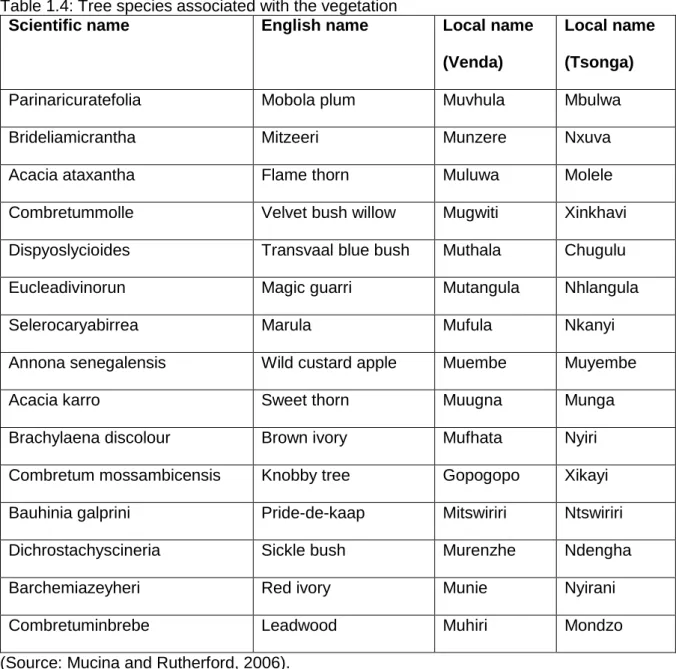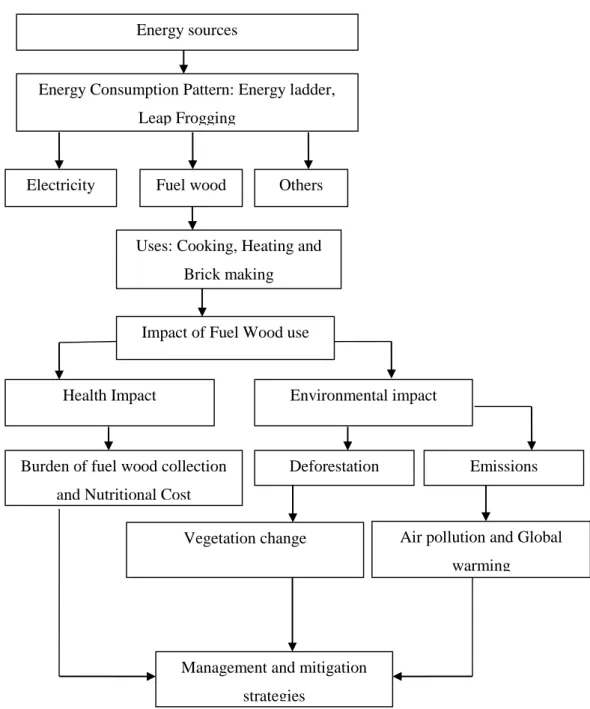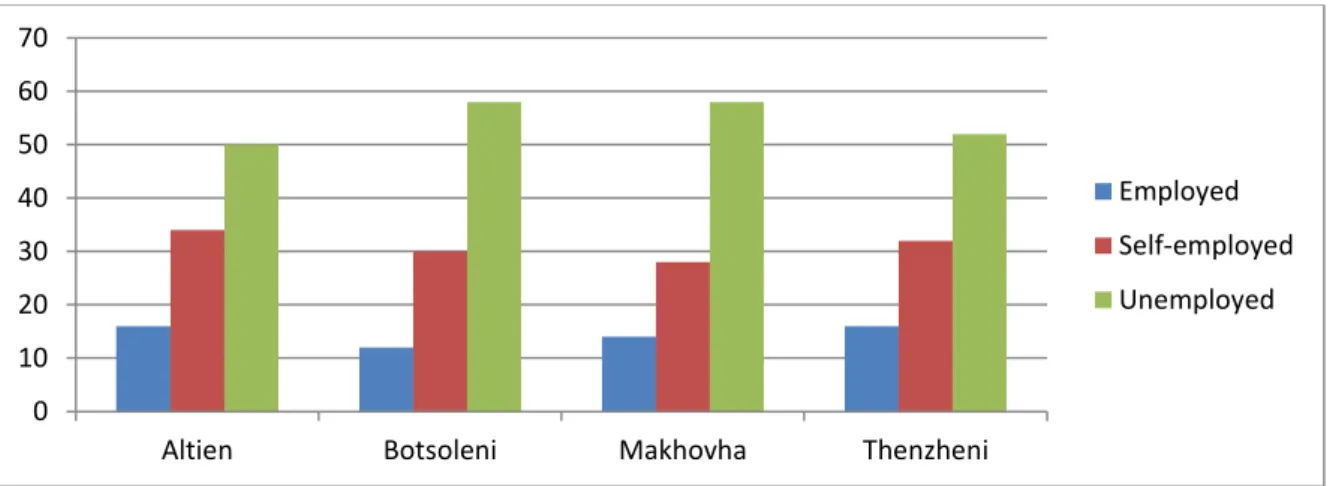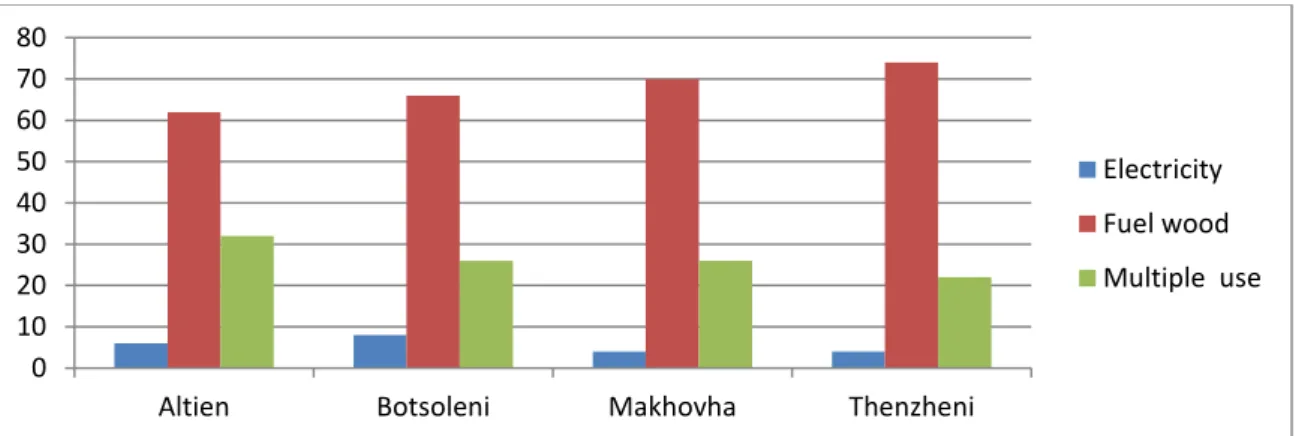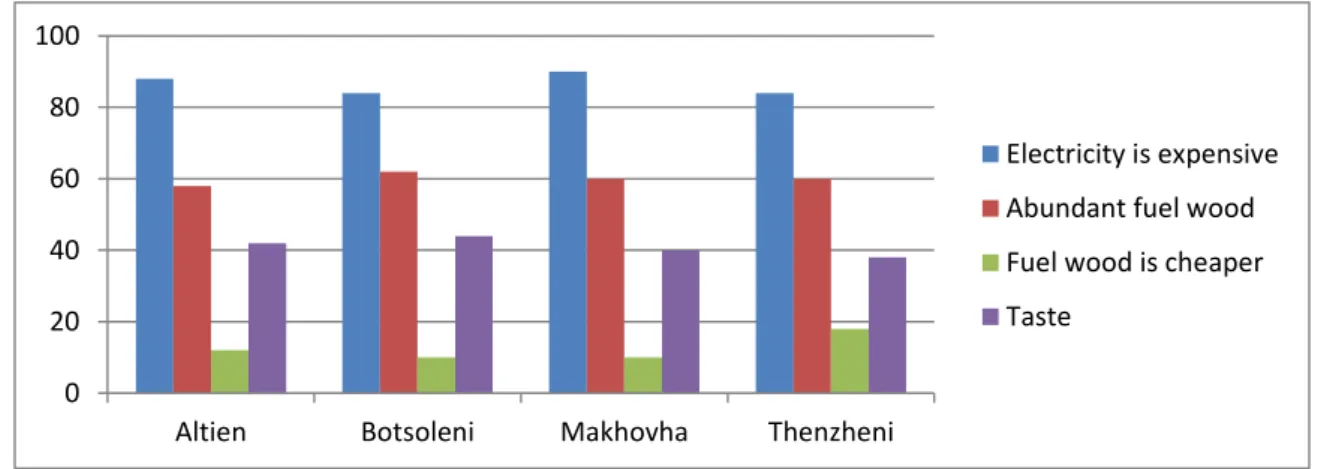Fuel wood is considered an important source of energy throughout the world, especially in developing countries. The data were analyzed using the Statistical Package for the Social Sciences (SPSS 21.0), showing the frequency distribution, measures of central tendency and chi-square to determine the extent of fuelwood used in relation to electricity.
INTRODUCTION
- Background to the Study
- Statement of the Research Problem
- Research Aim and Specific Objectives
- Research Aim
- Specific Objectives
- Research Questions
- Delimitation and Description of the Study Area
- Delimitation of the Study
- Description of the Study Area
- Significance and Justification of the Study
- Operational Definitions
- Organisation of the Thesis Outline
The local municipality of Thulamela is located at the eastern tip of South Africa's Vhembe District in the Limpopo Province. The total household in the municipality is 156,594, spread over about 228 villages and composed almost entirely of the Venda tribe (Statistic South Africa, 2011).
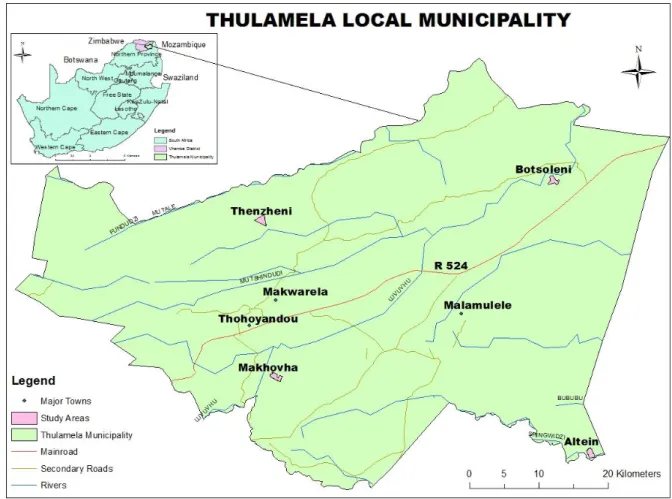
LITERATURE REVIEW
Introduction
Nature and Significance of Rural Energy Use
In many parts of sub-Saharan Africa, more than 90% of the rural population depends on firewood and charcoal as a source of energy. Poor households in Asia and Latin America are also highly dependent on firewood as an energy source (FAO, 2004).
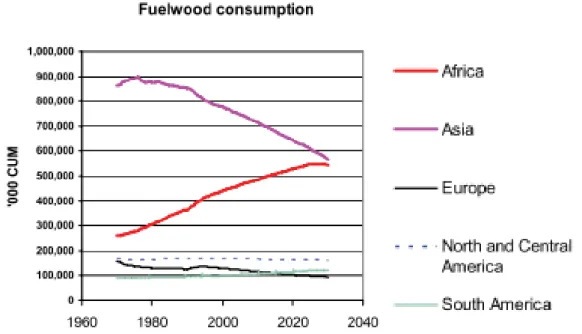
Energy, Atmospheric Emissions and the Environment
- Global Warming
- Air Pollution
The contribution of firewood to greenhouse gas emissions comes from the burning of biomass and the unsustainable way of cutting firewood (Hofsad, 2008). Gustafsson et al., 2009 found that biomass burning produces two-thirds of the total amount of carbon aerosols and more than half of black carbon.
Environmental Impact of Fuel Wood Harvesting
- Deforestation
- Hydrology
- Biodiversity Loss
- Soil Erosion
Unlike Africa, where most of the fuelwood production is small-scale, much of the fuelwood production in Asia comes from plantations. Once a forested area is deforested, too much water flow can cause flooding downstream, which can cause disasters in many parts of the world.
Health Impacts of Energy Extraction
- The Burden of Fuel Wood Collection
- Health and Nutritional Cost
The burden of fuelwood collection leads to the choice of foods with shorter cooking times instead of those with longer cooking times. It is claimed that the burden of collecting fuelwood leads to the substitution of regular food with long cooking hours.
Socio-Economic Patterns of Energy Consumption
- Energy Ladder Model
- Leap-Frogging
- The Consumer Behaviour Model
Because of the burden of collecting fuelwood, it is easy to visualize a direct and indirect cost to this factor, so that less food is cooked, there is a shift towards meals that require less cooking time, and the burden increases of work and economic burden for women. who are usually responsible for buying or collecting firewood. In the energy sector, a similar step-by-step concept can be used to show the transition from traditional forms of energy (e.g. fuelwood) to modern sources (e.g. electricity) (Murphy, 2001) without passing necessarily in the conventional path of energy development (i.e.
Integration of GIS and Remote Sensing in Vegetation Change Detection
Consumer behavior towards a product is influenced by three factors. These are the way the consumer perceives the product, the belief about the product and the current situation of the consumer (Mmatloa, 2010). Vegetation reflectance is highest in the green to near-infrared (NIR) zone because reflectance is much higher in the visible band due to the cellular structure of leaves. Or the index is calculated by dividing the difference of the near infrared (NIR) bands by their sum as the equation given below.
It is quite difficult to determine the accuracy of the ground-based estimates, as the errors in the FAO estimates are unknown.
Management Strategies in combating fuel wood harvesting and consumption
- Solar Energy
- Wind Energy
- Nuclear Energy
- Biogas Energy
The advantages of solar power over fossil fuels are, first, in the fact that it is a renewable form of energy; it's never going to run out and second is its effect on the environment. Indeed, incorporating solar energy into every home and business will result in no land being destroyed in the name of energy generation. The decentralization ability of solar energy is something that burning fossil fuels cannot match, as the primary element in the construction of solar panels is silicon and is the second most common element on the planet and environmental disturbance caused by the creation of solar panels is very little (Borchers et al., 2007).
The use of biogas systems offers several advantages, which include, in the process of anaerobic digestion, the organic nitrogen in the manure is largely converted to ammonium.
Mitigation Strategies in combating fuel wood harvesting and consumption
- Cooking with Energy-Efficient Improved Stoves
- Harvest Control
- Afforestation and Plantations
- Environmental Education
There were a number of large-scale plantations in the 1980s and 1990s to increase the supply of firewood (Evans and Turnbull, 2004). Some plantations resulted in the production of poles and lumber for construction that were quite profitable, but they barely successfully supplied charcoal and firewood to urban consumers. However, in some places, plantations are becoming increasingly important as a source of firewood for commercial use.
In South Africa, fuelwood and deforestation issues are published in publications such as Vukuzenzele, which are available free to all.
Conceptual Framework
RESEARCH METHODOLOGY
- Introduction
- Research Design
- Type of Design
- Sampling methods, Size and Unit of Analysis
- Ethical Considerations
- Data Collection Procedures
- Questionnaire Survey
- Physical Measurement of Fuel Wood
- Remote Sensing Imagery
- Focus Group Discussions
- Field Observation
- Document Analysis
- Data Analysis
- Questionnaire Analysis
- Fuel Wood Consumption and Emissions Calculations
- Image Interpretation using Remote Sensing Technique
- Focus Group Analysis
- Field Observation
Furthermore, the following criteria were used to justify the selection of the study areas: electrification, forest cover, and ecological environment under the threat of firewood harvesting. The information collected was used to achieve objective 1 and 2, which is to determine the socio-economic profile of the respondents and the extent of wood use in relation to electricity, as well as objective 3, which aims to determine the amount of carbon dioxide of carbon. emissions from fuelwood. The first requires wood fuel consumption rates and emission factors (Ludwig et al., 2003; Bhattachayra et al., 2000).
To determine the amount of carbon dioxide, the recorded mass of the fuelwood was used and the generic guideline used to calculate the carbon dioxide content of the fuelwood was followed.

DATA PRESENTATION AND ANALYSIS OF RESULTS
Introduction
Socio-Economic Characteristics of the Respondents
- Gender of the Respondents
- Education Level of Respondents
- Employment Status
- Household Income
The employment status of the respondents is crucial as it shows how the households can access resources. The field research shows that for Altein 16% of the respondents were employed, 34% self-employed and 50% considered half of the total survey unemployed. Comparing the employment level of the respondents in this survey shows that the unemployment rate is higher than that of the self-employed and employees.
This study showed that high unemployment has a drastic effect on the environment, as most of the unemployed use.

Energy Mix of the Communities
- Cooking
- Water Heating
- Perceptions for Energy Usage
The perceptions of the respondents on why certain energy sources are preferred were also established from the questionnaires. In Altein, 88% of respondents determined that electricity is expensive, 58% use fuelwood because of its abundance, 12% use fuelwood because it is cheaper than other forms of available energy and 42% believed that meals prepared with fuelwood taste better , 84% of Botosleni respondents indicate that electricity is expensive, 62% agree that fuelwood is abundant and 10% say fuelwood is a cheaper source of energy and 44% attribute this to taste.
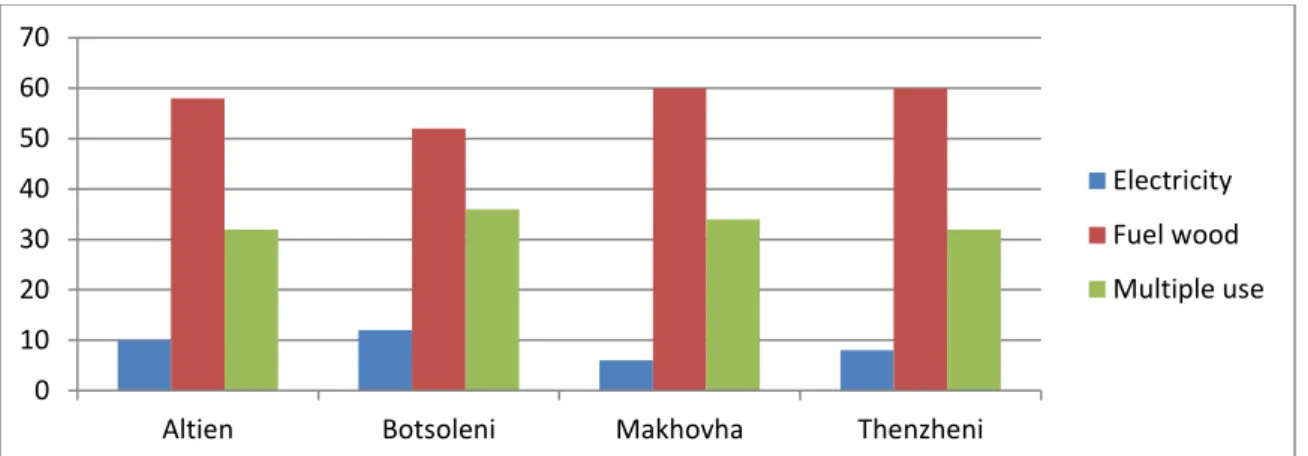
Fuel Wood Consumption and Emissions of Greenhouse gases
Deforestation in the Studied Villages
- Access to Fuel Wood and Harvesting Preference
- Rate and Extent of Deforestation from Satellite Imagery
- Environmental Impacts of Fuel Wood Extraction
Makovha has 78% harvest from the flat plain; 20% from the mountain and 2% from the river bank, while Thenzheni has 84% from the flat plain, 8% from the mountain and 8% prefer to harvest along the river. The figure above shows that the plain is most affected by deforestation, threatening Dichrostachys cineria and Combretum inbrebe as they dominate the plain. However, a loss of vegetation was observed in 2012, with the use of firewood by the communities being an important factor.
To calculate the vegetation change, the vegetation cover calculated from the images for the year 2007 was subtracted from the vegetation cover for the year 2012.

An Evaluation of Sustainable Energy Provision Using SWOT Analysis
Generated energy can meet household needs through the supply of electricity that can be used for cooking. Methane can be produced by anaerobic decomposition of animal manure, agricultural residues and other organic matter. From the SWOT analysis, the energy supply strategy that best suits the needs of society is the mix of solar energy and biogas.
Burgess is also a viable alternative because members of the Altein, Botsoleni, Makovha and Thenzheni communities' rear domestic animals in their households and the manure can be converted for energy production.
DISCUSSION OF THE FINDINGS
- Introduction
- Socio Economic Profile and Energy
- Income and Energy Sources
- Household Size and Energy Sources
- Accessibility and Energy Sources
- Energy Preferences
- Greenhouse Gas Emissions from Fuel Wood Consumption
- Environmental Impacts of Fuel Wood Harvesting and Usage
- Deforestation
- Hydrology
- Biodiversity Loss
- Soil Erosion
- Air Pollution
- Burden of Fuel Wood Collection
The extent of fuelwood used in relation to electricity is mainly determined by the socio-economic status of the consumers. Therefore, they turn to fuelwood because they have access to the forest to harvest fuelwood. It is estimated that most of the removed wood is used as fuel wood.
The harvesting of firewood in the villages is one of the factors that has contributed to the area's vulnerability to soil erosion.
CONCLUSIONS AND RECOMMENDATIONS
Introduction
Conclusion
- Energy Consumption and Households Income
- Greenhouse Gas Emissions
- Forest Depletion
- Alternative Energy
Deforestation is a major problem that can accelerate soil erosion, loss of biodiversity and affect the hydrology of the area. The study villages are typical rural settings such that fuelwood harvesting is one of the main factors causing deforestation. Although the villages are witnessing developmental progress in terms of construction (commercial and residential) and widening of roads, the rapid depletion of forest status can be said to be the result of fuelwood harvesting.
The municipality can also benefit from the government's awareness campaign on the use of sustainable energy of which renewable energy is a top priority.
Recommendations
- Environmental Education and Public Awareness
- Afforestation, Plantation and Harvest Control
- Provision of Cost Effective Energy
- Improved Cooking Stoves
- Enforcement of Environmental Legislation
The use of renewable energy will change people's lives, especially women and children, as they will no longer walk long distances in search of fuelwood and carry heavy overhead. From the study, it is impossible to exclude the continued use of wood for fuel by the communities. These stoves can help reduce air pollution associated with burning fuel wood while cooking.
Fuelwood Supply in Developing Countries, Food and Agriculture Organization, Rome, Italy, Forestry Book no. 42. The following household questionnaire will be distributed to village communities (Altein, Botsoleni, Makhova and Thenzheni) in Thulamela Local Municipality, Limpopo Province regarding fuelwood harvesting and deforestation. Interview questions are addressed to the tribal chief or village head to obtain views related to firewood harvesting and deforestation.
